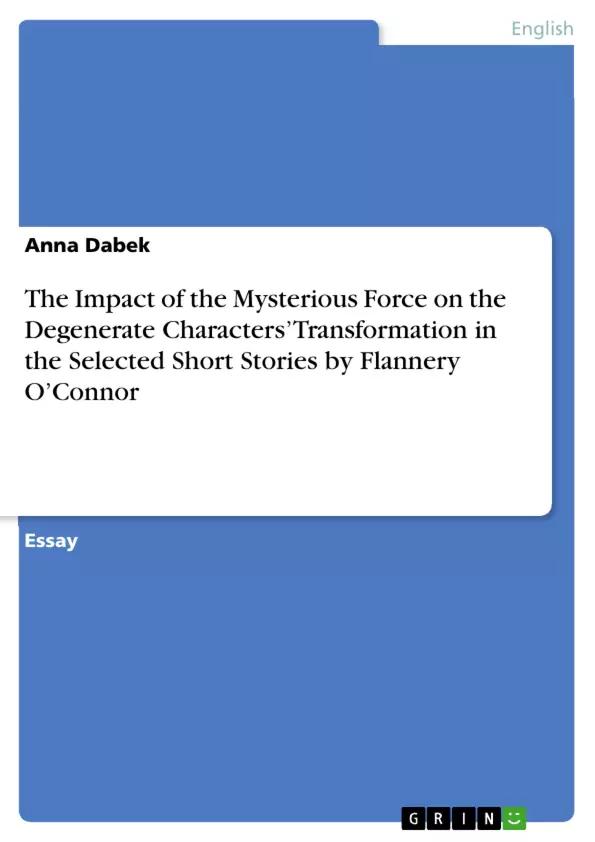The readers who are familiar with Flannery O’Connor’s fictional world might probably admit that it resembles a gallery of freaks deformed both in body and spirit. Her short stories contain numerous portrayals of aberrant behaviour as well as frequent descriptions of pathological states. Moreover, the author acquaints the reader with her characters’ predicament and its consequences. It seems that an inherent element of these protagonists’ abnormal behaviour is their total lack of control over their lives. Although they believe, they are capable of holding their fate in their own hands, their impotence invariably becomes apparent. O’Connor’s characters suffer defeat attempting to wield influence on their actions and end up entangled in the destructive vortex they cannot defy. These struggles often lead to death. Alternatively, the protagonists experience the state of death-in-life. The American writer’s stories portray the figure whose existence is submitted to the supremacy of a mysterious force. This inexplicable energy contributes to the alleviation of the character’s desperate state, induced by his abnormal conduct.
How does the aberrant behaviour manifest itself and how does the afflicted hero eliminate chaos from his life? First of all, the significance of death in the protagonist’s metamorphosis is worth mentioning. Patrick Galloway portrays O’Connor’s characters’ death as a positive process. Her short stories abound with violent and shocking scenes of death. For instance, the Polish immigrant, Guizac, is crushed by a tractor in “The Displaced Person”; Mrs May, the main heroine of “Greenleaf”, meets her end being impaled on the bull’s horn; the grandmother gets shot by the serial killer in “A Good Man is Hard to Find” and two main heroes of “A View of the Woods” – Mr Fortune and his granddaughter beat each other to death. Appalling and useless as the brutality of these scenes appears, it fulfils an essential function.
Inhaltsverzeichnis (Table of Contents)
- The Impact of the Mysterious Force on the Degenerate Characters' Transformation in the Selected Short Stories by Flannery O'Connor
- Death as a Catalyst for Transformation
- The Grandmother's Self-Made World
- The Transformation Begins From the Outside
Zielsetzung und Themenschwerpunkte (Objectives and Key Themes)
This essay explores the impact of a mysterious force on the transformation of degenerate characters in selected short stories by Flannery O'Connor. It analyzes how O'Connor uses death, external stimuli, and internal epiphanies to force her characters to confront the limitations of their self-made worlds and ultimately achieve grace.
- The Role of Death in Character Transformation
- The Limitations of Self-Made Worlds
- The Influence of External Stimuli
- The Importance of Epiphany and Grace
- O'Connor's Use of Nature and Human Interaction
Zusammenfassung der Kapitel (Chapter Summaries)
- The Impact of the Mysterious Force on the Degenerate Characters' Transformation in the Selected Short Stories by Flannery O'Connor: This section introduces the central theme of the essay – the impact of a mysterious force on the transformation of O'Connor's characters. It highlights the recurring motif of degenerate characters whose lives are governed by their own limited perceptions and the consequences of their actions.
- Death as a Catalyst for Transformation: This section delves into the significance of death as a catalyst for transformation in O'Connor's short stories. It examines how the extreme use of violence serves as a means for characters to confront the reality of their existence and experience a form of salvation through the loss of control.
- The Grandmother's Self-Made World: This section focuses on the character of the grandmother in "A Good Man is Hard to Find." It analyzes her limited vision of life, her reliance on nostalgia and self-deception, and the ultimate consequences of her distorted perception. The section explores how her confrontation with The Misfit leads to a profound realization of her own limitations and a final acceptance of grace.
- The Transformation Begins From the Outside: This section explores the role of external factors in initiating the transformation of O'Connor's characters. It examines how nature, human interaction, and traumatic events create a sense of unease and disrupt the characters' comfortable realities, ultimately leading to a process of growth and understanding.
Schlüsselwörter (Keywords)
Flannery O'Connor, short stories, degenerate characters, transformation, death, external stimuli, epiphany, grace, self-made worlds, limited vision, nature, human interaction, trauma, chaos, mysterious force, salvation, "A Good Man is Hard to Find", "Greenleaf", "A View of the Woods", "Parker's Back"
- Quote paper
- M.A. Anna Dabek (Author), 2008, The Impact of the Mysterious Force on the Degenerate Characters’ Transformation in the Selected Short Stories by Flannery O’Connor, Munich, GRIN Verlag, https://www.grin.com/document/284450



